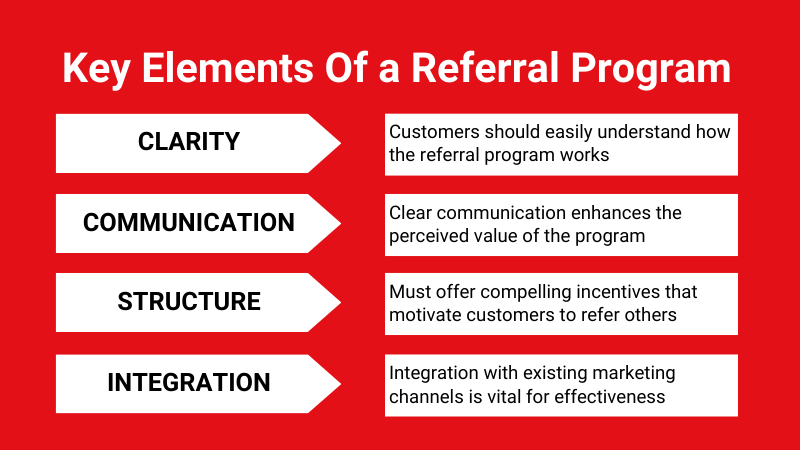Introduction
In today’s noisy and cluttered marketplace, businesses are constantly looking for new ways to stand out from the competition. One powerful tool that can be leveraged to accomplish this is a well-crafted referral program. When executed effectively, a referral program can not only boost customer acquisition but also strengthen customer loyalty and drive sustainable business growth.
Imagine having an army of loyal customers who not only love your products or services but also actively promote them to their friends, family, and colleagues. That’s the power of a well-designed referral program. By encouraging and incentivising your existing customers to refer your business to others, you can tap into a valuable source of high-quality leads.
In this article, we will explore the key components of a successful referral program and how it can skyrocket your business’s growth. We will delve into the various strategies and tactics that can be employed to optimise your program’s effectiveness and generate a constant stream of referrals.
So, whether you’re a small business owner or a marketing professional looking to take your organisation to the next level, get ready to unlock the full potential of referrals and propel your business forward.
Key Takeaways
- Referrals Build Trust: Referrals leverage existing trust between a referrer and potential customers, resulting in higher conversion rates.
- Cost-Effective Growth: Referral programs provide a cost-effective way to acquire new customers compared to traditional advertising.
- Improved Customer Loyalty: Customers acquired through referrals tend to have higher satisfaction and retention rates.
- Psychology Drives Referrals: Social proof, emotional connections, and reciprocity play key roles in motivating referrals.
- Incentives Are Critical: Tailoring rewards to your audience increases participation and engagement in referral programs.
- Integration is Key: Seamless integration with marketing channels boosts visibility and effectiveness.
- Continuous Improvement: Tracking, measuring, and optimizing referral programs ensure long-term success.
Table of Contents
- Introduction: The Power of Referrals
- Why Referrals Drive Business Growth
- The Psychology Behind Referrals
- How to Create a Referral Program That Works
- Key Elements of an Effective Referral Program
- Examples of Successful Referral Programs
- Implementing And Promoting Your Referral Program
- Tracking and Measuring Success
- Common Challenges and Solutions
- FAQs
- Final Thoughts
The importance of referrals in business growth
Referrals are often regarded as one of the most effective mechanisms for business growth. This is primarily because they leverage the trust established between a referrer and a potential customer. When an existing customer shares their positive experience with your product or service,
it serves as a personal endorsement that resonates more deeply than traditional advertising methods. This word-of-mouth marketing is not only cost-effective, but it also generates leads that are often more likely to convert, as they come with a built-in level of trust.
In addition to driving new customer acquisition, referrals play a crucial role in fostering long-term relationships. Customers who are referred to a business tend to have a higher retention rate. They are often more satisfied with their purchases because they have received recommendations from someone they trust.
This satisfaction leads to increased customer loyalty, which is invaluable in a competitive market where retaining customers can be just as challenging as acquiring new ones. As a result, businesses that prioritise referrals often see a significant impact on their overall growth trajectory.
Furthermore, a strong referral base can also enhance your brand reputation. When customers advocate for your business, they are essentially becoming brand ambassadors. This organic promotion not only increases visibility but can also attract the attention of potential clients who may not have been aware of your offerings before.
By cultivating a robust referral network, businesses can create a powerful marketing engine that continually fuels growth and helps maintain a competitive advantage.
Understanding the psychology behind referrals
To effectively harness the power of referrals, it’s essential to understand the psychological factors that drive them. At the core of referrals lies the concept of social proof. People are inherently influenced by the actions and opinions of others, especially when making purchasing decisions.
When a friend or family member recommends a product or service, it serves as validation, making the new customer feel more confident in their choice. This psychological phenomenon is why referrals can often lead to higher conversion rates compared to other forms of advertising.
Another critical aspect is the emotional connection associated with referrals. When someone refers a business to another person, they are not only sharing a product but also a piece of their identity. Recommenders often want to be seen as knowledgeable and helpful, which prompts them to share brands they trust.
This desire to maintain a positive self-image can lead to an increase in referrals, as individuals seek to associate themselves with businesses that reflect their values and standards.
Moreover, the principle of reciprocity plays a significant role in the psychology of referrals. When customers receive a benefit from a business, such as a discount or a reward for referring others, they feel compelled to reciprocate.
This creates a cycle where both the referrer and the referred customer benefit, ultimately driving more referrals. By understanding these psychological drivers, businesses can tailor their referral programs to tap into these innate human behaviours and effectively boost their referral rates.

How to create a referral program that works
Creating a referral program that truly works requires a strategic approach that combines elements of design, communication, and continuous improvement. To begin, you should define your goals clearly. Understanding what you want to achieve with your referral program is the foundation for its success.
Whether it’s increasing brand awareness, acquiring new customers, or boosting sales, having well-defined objectives will help guide the design and implementation of your program.
Next, it’s essential to engage with your customers to gain insights into what motivates them. Surveying existing customers can provide valuable information about their preferences and expectations regarding referral incentives.
This feedback can guide the development of a program that resonates with your audience and encourages active participation. Additionally, consider segmenting your audience to tailor the referral program to different customer groups, ensuring that the incentives are relevant to each segment.
Once you have a clear understanding of your goals and audience, it’s time to design the program. Focus on creating a user-friendly experience that makes it easy for customers to refer others. This includes a straightforward process for sharing referral links, tracking referrals, and redeeming rewards.
A well-designed landing page that explains the program and its benefits can significantly enhance user engagement. Finally, implement a system for monitoring and analysing the program’s performance, allowing you to make data-driven adjustments over time to optimise results.
Elements of an effective referral program
Creating an effective referral program involves several essential elements that work together to maximize its potential. Firstly, clarity is paramount. Customers should easily understand how the referral program works, including what actions they need to take and what rewards they can expect.
Providing straightforward guidelines helps eliminate confusion and encourages participation. Clear communication can also enhance the perceived value of the program, making customers more likely to engage.

Another crucial element is the incentive structure. A successful referral program must offer compelling incentives that motivate customers to refer others. These incentives can take various forms, such as discounts, cash rewards, or exclusive products.
The key is to align the incentive with your target audience’s preferences and values. For example, a brand that sells premium products might offer exclusive access to new collections, while a service-based business could provide discounts on future services. By tailoring incentives to your audience, you can enhance participation rates significantly.
Lastly, seamless integration with existing marketing channels is vital for the effectiveness of a referral program. Utilizing email campaigns, social media, and your website can help promote the program and make it easily accessible for customers.
Additionally, tracking tools should be in place to monitor referrals and reward participants promptly. This integration not only streamlines the process but also reinforces the program’s visibility, encouraging ongoing participation and engagement.
Examples of successful referral programs
Several companies have successfully harnessed the power of referral programs, demonstrating their effectiveness in driving growth and customer loyalty. One notable example is Dropbox, which implemented a referral program that offered additional storage space to both the referrer and the new user.
This program not only incentivized existing users to share the platform with their networks but also provided new users with an immediate sense of value. As a result, Dropbox experienced exponential growth, rapidly increasing its user base through referrals.
Another example is Airbnb, which has effectively utilized referrals to expand its marketplace. Their program offers existing users travel credits for referring friends who book a stay on the platform. This dual incentive structure encourages both the referrer and the new customer to engage with the service, creating a win-win situation.
By integrating referrals into their overall marketing strategy, Airbnb has successfully built a robust community of users who actively promote the platform to others.
Lastly, Tesla has managed to create a buzz around its referral program by offering unique rewards, such as exclusive access to events and even chances to win a new car. This approach not only incentivizes existing customers to spread the word about Tesla but also fosters a sense of community among brand advocates.
By showcasing the value of their offerings and the excitement surrounding their brand, Tesla’s referral program has played a significant role in driving sales and enhancing customer loyalty.
Implementing and promoting your referral program
Once you have designed your referral program, the next step is to implement and promote it effectively. Start with a comprehensive launch plan that includes marketing strategies across multiple channels. Leverage your email list by sending out announcements and detailed information about the program to existing customers. Use social media to create buzz and encourage sharing, and consider running targeted ads to reach a broader audience. The more visibility your program has, the more likely it is to succeed.
Another effective strategy is to integrate the referral program into your customer onboarding process. When new customers sign up or make their first purchase, take the opportunity to introduce them to the referral program. Highlight the benefits of participating and how easy it is to share with their network. This early engagement can encourage new customers to become advocates right from the start, setting a positive tone for their relationship with your brand.
Additionally, consider using gamification techniques to make the referral process more engaging. Creating leader boards or offering tiered rewards can motivate customers to participate actively. By making referrals a fun and competitive experience, you can encourage more people to join in and spread the word about your business.
Regularly communicating updates and success stories related to your referral program can also keep the momentum going and maintain enthusiasm among participants.
Tracking and measuring the success of your referral program
To ensure the effectiveness of your referral program, it is essential to establish clear metrics for tracking and measuring its success. Start by identifying key performance indicators (KPIs) that align with your goals, such as the number of referrals generated, conversion rates, and customer retention rates.
By analysing these metrics regularly, you can gain insights into how well your program is performing and identify areas for improvement.
Utilizing referral tracking software can streamline this process. Many platforms offer tools that allow you to monitor referrals in real-time, track rewards, and analyse the overall success of the program.
This data can provide valuable insights into which aspects of the program are resonating with customers and which may need tweaking. Additionally, make use of customer feedback to gather qualitative data about their experiences with the program. Understanding the customer perspective can help you refine the program and enhance its appeal.
Finally, consider setting up A/B testing for different aspects of your referral program. This could involve testing different incentives, promotional messages, or even the design of the referral interface.
By experimenting with various approaches, you can identify the most effective strategies for driving engagement and conversions. Continuous measurement and adaptation are key to maintaining the relevance and effectiveness of your referral program in a dynamic market.
Common challenges and how to overcome them
While implementing a referral program can be a game-changer for your business, it is not without its challenges. One common issue is low participation rates. Customers may not be motivated enough to refer others, either due to a lack of understanding of the program or insufficient incentives.
To overcome this challenge, ensure that your program is easy to comprehend and that the rewards are compelling enough to encourage participation. Regularly communicate the benefits of the program and share success stories to inspire others to get involved.
Another challenge is tracking and measuring referrals effectively. Without proper tracking, it can be challenging to determine the program’s success and make necessary adjustments. To address this, invest in reliable referral tracking software that provides real-time data and insights.
This will help you monitor participant engagement, track conversions, and identify any bottlenecks in the referral process. Ensuring transparency in how referrals are tracked can also help build trust among participants.
Lastly, maintaining momentum for your referral program can be difficult over time. Participants may lose interest if they perceive the program as stagnant. To combat this, consider introducing new incentives or gamifying the experience to keep things fresh and exciting.
Regularly update your customers about the program and celebrate milestones, such as reaching a certain number of referrals. By consistently engaging with your audience and promoting the program, you can sustain interest and participation over the long term.
FAQs:
Q: What is a referral program, and why is it important?
A: A referral program is a marketing strategy where existing customers are incentivised to refer new customers to your business. It’s important because it leverages trust, generates high-quality leads, and is a cost-effective way to grow your customer base.
Q: What are the key components of a successful referral program?
A: A successful referral program includes clear guidelines, compelling incentives, seamless integration with marketing channels, and tools for tracking and measuring success.
Q: How can I ensure my referral program continues to be effective over time?
A: Regularly update incentives, use gamification to keep participants engaged, and analyse performance data to optimize the program. Share success stories and maintain communication with participants to sustain interest.
Final Thoughts:
Leveraging the power of referrals can be a transformative strategy for businesses seeking sustainable growth. A well-crafted referral program not only enhances customer acquisition but also fosters loyalty and strengthens brand reputation.
By understanding the psychology behind referrals and implementing effective strategies, businesses can create a powerful marketing engine fuelled by the advocacy of satisfied customers.
The key to success lies in designing a referral program that is easy to understand, offers compelling incentives, and integrates seamlessly with existing marketing efforts. By promoting the program effectively and continuously tracking its performance, businesses can make data-driven adjustments to optimise results.
Additionally, addressing common challenges and maintaining engagement will ensure that the referral program remains relevant and impactful over time.
Ultimately, in a marketplace that thrives on trust and personal connections, referrals offer a unique advantage. By unlocking this potential, businesses can cultivate a loyal customer base that actively promotes their brand, leading to exponential growth and long-term success.
Embracing the power of referrals is not just about gaining new customers; it’s about transforming your existing relationships into a powerhouse of advocacy that propels your business forward in an increasingly competitive landscape.
Speak soon.
- Referral Success: The Art of Long-Term Referral Relationship Building - March 19, 2025
- 10 Rules of Referral Marketing - February 26, 2025
- The Power of Referrals: How a Well-Crafted Referral Program Can Skyrocket Your Business - February 16, 2025

